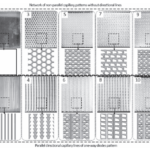Bioware fog collectors: the Texas horned lizard as a model for a biomimetic fog-harvesting
The main aim of this research is to demonstrate the potential of surfaces with structural modifications for passive directed fog collection water transport, which might lead to process improvements and reduced resource requirements due to exceedingly controllable transporting of tiny droplets. For this purpose, we analyzed the fog collection efficiency of two various categories of the bio-inspired geometric patterned surface: samples in category A with parallel directional capillary lines of the oneway diodes pattern and category B consist of samples with a network of non-parallel capillary patterns without directional lines. The fog collection efficiency of the samples of each category was tested at different depths and in two hydrophobic and hydrophilic wettability states. In addition to that fog collection efficiency of the samples was compared in each category separately to investigate the influence of microstructures and/or the wettability of the surfaces on fog collection. The results indicate that the Texas horned lizard geometric patterned surface enhanced the effective transport of collecting water tiny water droplets toward the bottom of the surface patterns. The results of these experiments can be materialized to develop an efficient fog collector and planar microfluidics.
Learn about our two Decals!
 Click here to find out more about our Fall Bioinspired Design Decal and our Spring Bioinspired Design in Action Decal – ALL MAJORS are welcome.
Click here to find out more about our Fall Bioinspired Design Decal and our Spring Bioinspired Design in Action Decal – ALL MAJORS are welcome.Berkeley BioDesign Community
 Click here to learn about the BioD: Bio-Inspired Design @ Berkeley student organization or here to signup for more info.
Click here to learn about the BioD: Bio-Inspired Design @ Berkeley student organization or here to signup for more info.Search
Student Login





I imagine that the neurological circuits underlying these processes are governed by both 2d spacing maps with their brains as…
to reduce the impact of car accidents, it may be possible to study the force diverting physics of cockroaches to…
you see this type of head-bobbing stability in many avian creatures related to pigeons like chickens. the head ability to…
not like they taught horses how to run! this is an example of convergent evolution where both sea creatures and…
The brain functions in a similar way with neuronal connections. our brains are able to utilize the multiplicity of connections…